#truly believe mags is actually terrifying in a fight (assuming he wants to be there and is fighting *for* something)
Note
🗡️ fighting styles/combat? For any Fëanorian, or another character of your choice!
🗡️ - Fighting styles/combat.
picking maglor, and i'm sure you're all very surprised by that😂
maglor wields a sword in either hand with equal efficacy. i've explained this hc before but i can't find the post (tumblr is being The Most Functional Website again). essentially, maglor did the right thing by his people when he didn't try for a rescue of maedhros three kings in two years, but he couldn't quite forgive himself for it anyway. so when maedhros started learning how to fight again maglor turned up with his sword in his left hand so they could learn at the same time. sort of half apology, half getting to know each other anew
also, the best mounted archer of his siblings! this is mostly down to practice practice practice, because he's out on the plains on the front lines of the leaguer and using that skill constantly. celegorm is very nearly as good, but he cut his teeth in the hunt on wild animals, and maglor cut his teeth on the march shooting at things that shot back. (and he's just a little better a rider besides)
bonus not-maglor headcanon: caranthir pioneers net fighting with a spear. thargelion doesn't really need, or have, tridents like the falathrim use for both fishing and fighting, there's nothing big enough to warrant them. but fishing spears are pretty common near helevorn. i think he maybe got caught out without a sword once, found out that fighting w a net + spear suited him a lot better, and left his sword to gather dust unless he knew he's be fighting in close quarters
unusual headcanons ask game here
#thanks for the ask!#maglor#caranthir#silmarillion#silm headcanons#ask games#truly believe mags is actually terrifying in a fight (assuming he wants to be there and is fighting *for* something)#he just doesnt get the 'fled before his face' treatment by virtue of looking Standard Noldo#03/09 edited the last paragraph bc i wasnt sure i really made it clear enough that he's fighting w a spear not a trident
30 notes
·
View notes
Text
Top Misconceptions People Have about Pulp-Era Science Fiction
A lot of people I run into have all kinds of misconceptions about what pulp-era scifi, from the 1920s-1950s, was actually like.
“Pulp-Era Science Fiction was about optimistic futures.”
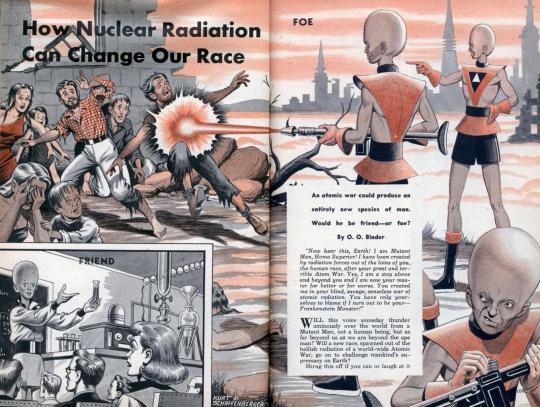
Optimistic futures were always, always vastly outnumbered by end of the world stories with mutants, Frankenstein creations that turn against us, murderous robot rebellions, terrifying alien invasions, and atomic horror. People don’t change. Then as now, we were more interested in hearing about how it could all go wrong.
To quote H.L. Gold, editor of Galaxy Science Fiction, in 1952:
“Over 90% of stories submitted to Galaxy Science Fiction still nag away at atomic, hydrogen and bacteriological war, the post atomic world, reversion to barbarism, mutant children killed because they have only ten toes and fingers instead of twelve….the temptation is strong to write, ‘look, fellers, the end isn’t here yet.’”

The movie Tomorrowland is a particulary egregious example of this tremendous misconception (and I can’t believe Brad Bird passed on making Force Awakens to make a movie that was 90 minutes of driving through the Florida swamps). In reality, pre-1960s scifi novels trafficked in dread, dystopian futures, and fear. There was simply never a time when optimistic scifi was overrepresented, even the boyish Jules Verne became skeptical of the possibilities of technology all the way at the turn of the century. One of the most famous pulp scifi yarns was Jack Williamson’s The Humanoids, about a race of Borg-like robots who so totally micromanage humans “for our own protection” that they leave us with nothing to do but wait “with folded hands.”
“Pulp scifi often featured muscular, large-chinned, womanizing main characters.”
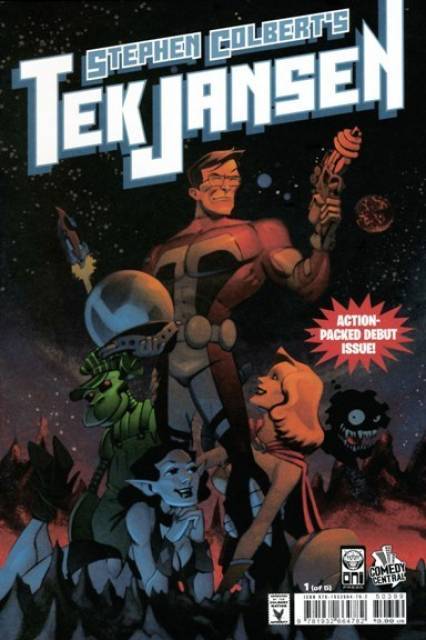
Here’s the image often used in parodies of pulp scifi: the main character is a big-chinned, ultra-muscular dope in tights who is a compulsive womanizer and talks like Adam West in Batman. Whenever I see this, I think to myself…what exactly is it they’re making fun of?
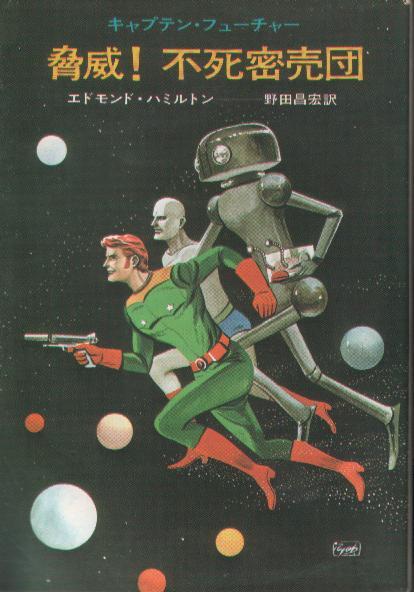
It’s more normal than you think to find parodies of things that never actually existed. Mystery buffs and historians, for example, can’t find a single straight example of “the Butler did it.” It’s a thing people think is a thing that was never a thing, and another example would be the idea of the “silent film villain” in a mustache and top hat (which there are no straight examples of, either). There are no non-parody examples of Superman changing in a phone booth; he just never did this.

In reality, my favorite description of pulp mag era science fiction heroes is that they are “wisecracking Anglo-Saxon engineers addicted to alcohol and tobacco who like nothing better than to explain things to others that they already know.” The average pulp scifi hero had speech patterns best described as “Mid-Century American Wiseass” than like Adam West or the Lone Ranger.
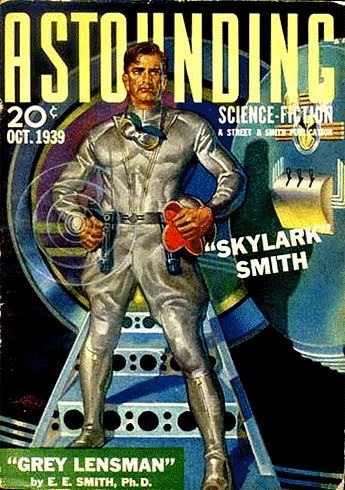
The nearest the Spaceman Spiff stereotype came to hitting the mark was with the magazine heroes of the Lensmen and Captain Future, and they’re both nowhere near close. Captain Future was a muscular hero with a chin, but he also had a Captain Picard level desire to use diplomacy first, and believed that most encounters with aliens were only hostile due to misunderstandings and lack of communication (and the story makes him right). He also didn’t seem interested in women, mostly because he had better things to do for the solar system and didn’t have the time for love. The Lensmen, on the other hand, had a ruthless, bloodthirsty streak, and were very much like the “murder machine” Brock Sampson (an attitude somewhat justified by the stakes in their struggle).
“Pulp Era Scifi were mainly action/adventure stories with good vs. evil.”
This is a half-truth, since, like so much other genre fiction, scifi has always been sugared up with fight scenes and chases. And there was a period, early in the century, when most scifi followed the Edgar Rice Burroughs model and were basically just Westerns or swashbucklers with different props, ray guns instead of six-shooters. But the key thing to remember is how weird so much of this scifi was, and that science fiction, starting in the mid-1930s, eventually became something other than just adventure stories with different trappings.

One of my favorite examples of this is A. Bertram Chandler’s story, “Giant-Killer.” The story is about rats on a starship who acquire intelligence due to proximity to the star drive’s radiation, and who set about killing the human crew one by one. Another great example is Eando Binder’s Adam Link stories, told from the point of view of a robot who is held responsible for the death of his creator.
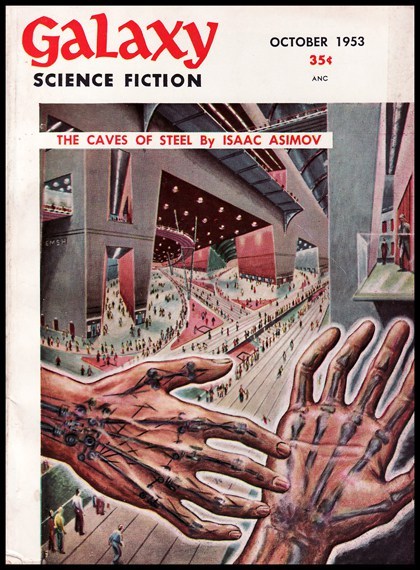
What’s more, one of the best writers to come out of this era is best known for never having truly evil bad guys: Isaac Asimov. His “Caves of Steel,” published in 1953, had no true villains. The Spacers, who we assumed were snobs, only isolated themselves because they had no immunities to the germs of earth.
“Racism was endemic to the pulps.”
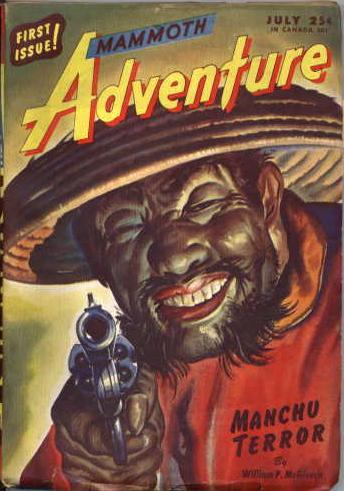
It is absolutely true that the pulps reflected the unconscious views of society as a whole at the time, but as typical of history, the reality was usually much more complex than our mental image of the era. For instance, overt racism was usually shown as villainous: in most exploration magazines like Adventure, you can typically play “spot the evil asshole we’re not supposed to like” by seeing who calls the people of India “dirty monkeys” (as in Harold Lamb).
Street & Smith, the largest of all of the pulp publishers, had a standing rule in the 1920s-1930s to never to use villains who were ethnic minorities because of the fear of spreading race hate by negative portrayals. In fact, in one known case, the villain of Resurrection Day was going to be a Japanese General, but the publisher demanded a revision and he was changed to an American criminal. Try to imagine if a modern-day TV network made a rule that minority groups were not to be depicted as gang bangers or drug dealers, for fear that this would create prejudice when people interact with minority groups in everyday life, and you can see how revolutionary this policy was. It’s a mistake to call this era very enlightened, but it’s also a mistake to say everyone born before 1970 was evil.
“Pulp scifi writers in the early days were indifferent to scientific reality and played fast and loose with science.”
FALSE.
This is, by an order of magnitude, the most false item on this list.

In fact, you might say that early science fiction fandom were obsessed with scientific accuracy to the point it was borderline anal retentive. Nearly every single one of the lettercols in Astounding Science Fiction were nitpickers fussing about scientific details. In fact, modern scifi fandom’s grudging tolerance for storytelling necessities like sound in space at the movies, or novels that use “hyperspace” are actually something of a step down from what the culture around scifi was in the 1920s-1950s. Part of it was due to the fact that organized scifi fandom came out of science clubs; Hugo Gernsback created the first scifi pulp magazine as a way to sell electronics and radio equipment to hobbyists, and the “First Fandom” of the 1930s were science enthusiasts who talked science first and the fiction that speculated about it second.

In retrospect, a lot of it was just plain obvious insecurity: in a new medium considered “kid’s stuff,” they wanted to show scifi was plausible, relevant, and something different from “fairy tales.” It’s the same insecure mentality that leads video gamers to repeatedly ask if games are art. You’ve got nothing to prove there, guys, calm down (and take it from a pulp scifi aficionado, the most interesting things are always done in the period when a medium is considered disposable trash).

One of the best examples was the famous Howard P. Lovecraft, who published “The Shadow out of Time” in the 1936 issue of Astounding. Even though it might be the only thing from that issue that is even remotely reprinted today, the letters page from this issue practically rose up in revolt against this story as not being based on accurate science. Lovecraft was never published in Astounding ever again.
If you ever wanted to find out what Star Wars would be like if they were bigger hardasses about scientific plausibility, check out E.E. Smith’s Lensman series. People expect a big, bold, brassy space opera series with heroes and villains to play fast and loose, but it was shockingly scientifically grounded.

To be fair, science fiction was not a monolith on this. One of the earliest division in science fiction was between the Astounding Science Fiction writers based in New York, who often had engineering and scientific backgrounds and had left-wing (in some cases, literally Communist) politics, and the Amazing Stories writers based in the Midwest, who were usually self taught, and had right-wing, heartland politics. Because the Midwestern writers in Amazing Stories were often self-taught, they had a huge authority problem with science and played as fast and loose as you could get. While this is true, it’s worth noting science fiction fandom absolutely turned on Amazing Stories for this, especially when the writers started dabbling with spiritualism and other weirdness like the Shaver Mystery. And to this day, it’s impossible to find many Amazing Stories tales published elsewhere.
3K notes
·
View notes